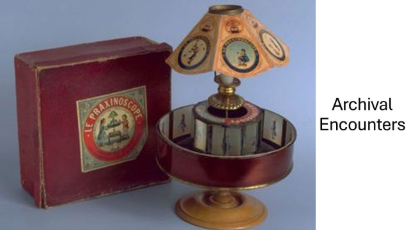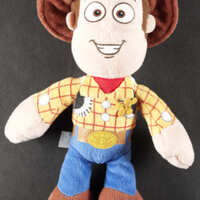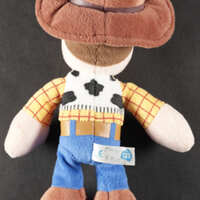Woody Soft Toy
Dublin Core
Title
Woody Soft Toy
Subject
A soft toy of Disney's film 'Toy Story' (1995)
Description
Woody, is a soft toy based on the image of Woody, the main character in the Disney-Pixar animated movie Toy Story(1995).Faithful to the character from the movie, this soft toy is 18" tall cuddly doll of the character Woody, from Disney's Toy Story (1995). The doll has blue trousers, a red and yellow checked shirt, and soft brown hat. Label on the back states 'Gift Prize. Not for Re-Sale.'
The soft toy Woody's facial expression is vivid and lovely, with brown eyes, brown eyebrows and smiling mouth, making it look friendly and kind. It is worth mentioning that in order to restore the image of the character in the movie, this soft toy is very attentive to details, Woody's belt, medallion and other elements are all using printing process, and the sole of Woody's foot is also iconic printed with the owner's name Andy. This kind of workmanship and details make the overall shape more realistic and restored.In terms of material, Woody's stuffed animal is made of soft plush material, and the inner stuffing is made of cotton, which is cozy and comfortable to touch, which reflects the environment of the characters in the show, i.e. children's toys, and this material is more suitable for children to play with. On the other hand, this material has a certain degree of wear resistance and tensile strength, which makes it more suitable for long-term storage and viewing as a museum exhibit.
Woody the soft toy takes on special significance as part of the Bill Douglas Cinema Museum's collection.First of all, for fans of the Toy Story series, the Woody soft toy is more than just a toy; it represents a reminder of the love of the movie series and the emotions of the characters. It can evoke fond memories of the movie's plot and characters. Because the movie products often have unique artistic designs, the design and production of Woody's soft toys reflect the artistic reproduction of the movie characters' images.The Toy Story series is not only a classic in the history of animated films, but also represents a part of pop culture. As the main character in the movie, Woody's derivative product image has also become a concrete expression of this cultural symbol. Moreover, for many people, Woody is actually more than just a toy in the movie, it represents the values of friendship, courage and loyalty. Woody's character inspires the movie fans and brings more positive emotional impact to the audience. The soft toy Woody is a derivative product of the movie, which serves as an emotional support, allowing the audience to feel an emotional connection with the movie characters and demonstrating respect for the movie's culture.
The character of Woody is established as a cowboy figure in Toy Story, thereby reflecting the spirit of the American West. In American culture, cowboys are associated with notions of justice, courage, and the spirit of adventure(Gay, A. et al. 2017). The setting of Woody serves not only as a tribute to the history of the American West but also as a reflection of the cowboy image in American culture. By positioning Woody as a cowboy, the film successfully establishes an emotional connection between this cultural symbol and the audience. In the narrative, Woody encounters competition from a new toy, Buzz Lightyear, which gives rise to internal conflict and personal growth. Initially, Woody experiences feelings of jealousy and marginalization in relation to Buzz Lightyear. However, as the narrative progresses, Woody learns to embrace acceptance and collaboration, reflecting a transformation in character. This character development not only enhances the narrative but also prompts the audience to reflect on themes of friendship, competition, and personal growth.
The character of Woody and his storyline have clear educational value. Primarily, the narrative illustrates how children can learn to confront changes and challenges, and to mature in the context of competition and conflict(‘Toys’ 2014). For instance, Woody, Andy's erstwhile favorite toy, is supplanted by Buzz Lightyear. Initially, Woody experiences feelings of envy and intimidation, and attempts to force Buzz into the lower shelf. However, Buzz falls from the window, resulting in his demise. Woody is erroneously perceived as intending to harm Buzz. Rather than allowing the misunderstanding to endanger Buzz, Woody and Buzz eventually discover a method for collaborating to return home. Secondly, the character of Woody and his narrative convey significant values pertaining to courage, responsibility, and teamwork. For example, Woody is persuaded by a toy collector, Stinky Pete, and Jessie that Andy will discard him, leading him to consider remaining with the collector. Upon learning that Buzz and the other toys are searching for him, Woody decides to return to Andy. Consequently, Woody and Buzz collaborate once more, guiding the remaining toys to evade the Toy Collector's establishment and return to Andy's residence. These elements elevate Woody from a mere plaything to an instructive figure. As the focal character in Toy Story, Woody's design and narrative not only mirror American culture but also encompass profound educational implications, a significant factor in the character's widespread appeal.
Toys as a derivative product of the movie, the market value of it will grow with the expansion of the influence of the movie(Fletcher, D. 2007). Toy Story is a very popular animated movie, and its movie derivatives rely on the fan economy, where fans' love and loyalty to the movie characters translates into purchasing power. The popularity and adorable appearance of Woody, the main character in the movie, attracts fans to buy and watch the movie.To further clarify, the Toy Story franchise is designed with an all-ages appeal, though it is particularly well-received by children and families. Disney and Pixar have ensured that the film appeals to fans of all ages through the creation of well-crafted narratives and characters. Furthermore, the release of movie spin-off soft toys, such as Woody, subsequent to the film's initial release has resulted in the character of Woody becoming an iconic Disney and Pixar brand. The enduring popularity of these characters has contributed to the sustained value of the Toy Story brand. As a result, the significant influence of the fan economy has made movie peripherals an integral aspect of the movie industry. This not only provides an additional source of revenue for movie producers but also facilitates the promotion and branding of the movie.
References:
Fletcher, D. (2007) ‘“Toy Story”: The narrative world of entrepreneurship and the creation of interpretive communities’, Journal of business venturing, 22(5), pp. 649–672. Available at: https://doi.org/10.1016/j.jbusvent.2006.10.001.
Gay, A. et al. (2017) ‘The Cowboy, the Spaceman and the Guru: Character and Convention in the Screenwriting of Toy Story’, in Toy Story. 1st edn. London: Bloomsbury Publishing Plc, pp. 39–58. Available at: https://doi.org/10.5040/9781501324949.ch-003.
‘Toys’ (2014) Childhood Studies. Oxford University Press. Available at: https://doi.org/10.1093/obo/9780199791231-0133.
The soft toy Woody's facial expression is vivid and lovely, with brown eyes, brown eyebrows and smiling mouth, making it look friendly and kind. It is worth mentioning that in order to restore the image of the character in the movie, this soft toy is very attentive to details, Woody's belt, medallion and other elements are all using printing process, and the sole of Woody's foot is also iconic printed with the owner's name Andy. This kind of workmanship and details make the overall shape more realistic and restored.In terms of material, Woody's stuffed animal is made of soft plush material, and the inner stuffing is made of cotton, which is cozy and comfortable to touch, which reflects the environment of the characters in the show, i.e. children's toys, and this material is more suitable for children to play with. On the other hand, this material has a certain degree of wear resistance and tensile strength, which makes it more suitable for long-term storage and viewing as a museum exhibit.
Woody the soft toy takes on special significance as part of the Bill Douglas Cinema Museum's collection.First of all, for fans of the Toy Story series, the Woody soft toy is more than just a toy; it represents a reminder of the love of the movie series and the emotions of the characters. It can evoke fond memories of the movie's plot and characters. Because the movie products often have unique artistic designs, the design and production of Woody's soft toys reflect the artistic reproduction of the movie characters' images.The Toy Story series is not only a classic in the history of animated films, but also represents a part of pop culture. As the main character in the movie, Woody's derivative product image has also become a concrete expression of this cultural symbol. Moreover, for many people, Woody is actually more than just a toy in the movie, it represents the values of friendship, courage and loyalty. Woody's character inspires the movie fans and brings more positive emotional impact to the audience. The soft toy Woody is a derivative product of the movie, which serves as an emotional support, allowing the audience to feel an emotional connection with the movie characters and demonstrating respect for the movie's culture.
The character of Woody is established as a cowboy figure in Toy Story, thereby reflecting the spirit of the American West. In American culture, cowboys are associated with notions of justice, courage, and the spirit of adventure(Gay, A. et al. 2017). The setting of Woody serves not only as a tribute to the history of the American West but also as a reflection of the cowboy image in American culture. By positioning Woody as a cowboy, the film successfully establishes an emotional connection between this cultural symbol and the audience. In the narrative, Woody encounters competition from a new toy, Buzz Lightyear, which gives rise to internal conflict and personal growth. Initially, Woody experiences feelings of jealousy and marginalization in relation to Buzz Lightyear. However, as the narrative progresses, Woody learns to embrace acceptance and collaboration, reflecting a transformation in character. This character development not only enhances the narrative but also prompts the audience to reflect on themes of friendship, competition, and personal growth.
The character of Woody and his storyline have clear educational value. Primarily, the narrative illustrates how children can learn to confront changes and challenges, and to mature in the context of competition and conflict(‘Toys’ 2014). For instance, Woody, Andy's erstwhile favorite toy, is supplanted by Buzz Lightyear. Initially, Woody experiences feelings of envy and intimidation, and attempts to force Buzz into the lower shelf. However, Buzz falls from the window, resulting in his demise. Woody is erroneously perceived as intending to harm Buzz. Rather than allowing the misunderstanding to endanger Buzz, Woody and Buzz eventually discover a method for collaborating to return home. Secondly, the character of Woody and his narrative convey significant values pertaining to courage, responsibility, and teamwork. For example, Woody is persuaded by a toy collector, Stinky Pete, and Jessie that Andy will discard him, leading him to consider remaining with the collector. Upon learning that Buzz and the other toys are searching for him, Woody decides to return to Andy. Consequently, Woody and Buzz collaborate once more, guiding the remaining toys to evade the Toy Collector's establishment and return to Andy's residence. These elements elevate Woody from a mere plaything to an instructive figure. As the focal character in Toy Story, Woody's design and narrative not only mirror American culture but also encompass profound educational implications, a significant factor in the character's widespread appeal.
Toys as a derivative product of the movie, the market value of it will grow with the expansion of the influence of the movie(Fletcher, D. 2007). Toy Story is a very popular animated movie, and its movie derivatives rely on the fan economy, where fans' love and loyalty to the movie characters translates into purchasing power. The popularity and adorable appearance of Woody, the main character in the movie, attracts fans to buy and watch the movie.To further clarify, the Toy Story franchise is designed with an all-ages appeal, though it is particularly well-received by children and families. Disney and Pixar have ensured that the film appeals to fans of all ages through the creation of well-crafted narratives and characters. Furthermore, the release of movie spin-off soft toys, such as Woody, subsequent to the film's initial release has resulted in the character of Woody becoming an iconic Disney and Pixar brand. The enduring popularity of these characters has contributed to the sustained value of the Toy Story brand. As a result, the significant influence of the fan economy has made movie peripherals an integral aspect of the movie industry. This not only provides an additional source of revenue for movie producers but also facilitates the promotion and branding of the movie.
References:
Fletcher, D. (2007) ‘“Toy Story”: The narrative world of entrepreneurship and the creation of interpretive communities’, Journal of business venturing, 22(5), pp. 649–672. Available at: https://doi.org/10.1016/j.jbusvent.2006.10.001.
Gay, A. et al. (2017) ‘The Cowboy, the Spaceman and the Guru: Character and Convention in the Screenwriting of Toy Story’, in Toy Story. 1st edn. London: Bloomsbury Publishing Plc, pp. 39–58. Available at: https://doi.org/10.5040/9781501324949.ch-003.
‘Toys’ (2014) Childhood Studies. Oxford University Press. Available at: https://doi.org/10.1093/obo/9780199791231-0133.
Creator
Toy Factory
Publisher
Pixar Animation Studios
Date
1995
Rights
© 1995 Disney/Pixar. All Rights Reserved.“Toy Story” is a trademark of Disney/Pixar.
Format
Soft Toy ,18''tall
Language
English
Type
Soft Toy
Identifier
BD67253
Collection
Citation
Toy Factory, “Woody Soft Toy,” Archival Encounters: Digital Exhibitions form the Bill Douglas Cinema Museum, accessed July 5, 2025, https://humanities-research.exeter.ac.uk/archivalencounters/items/show/64.


